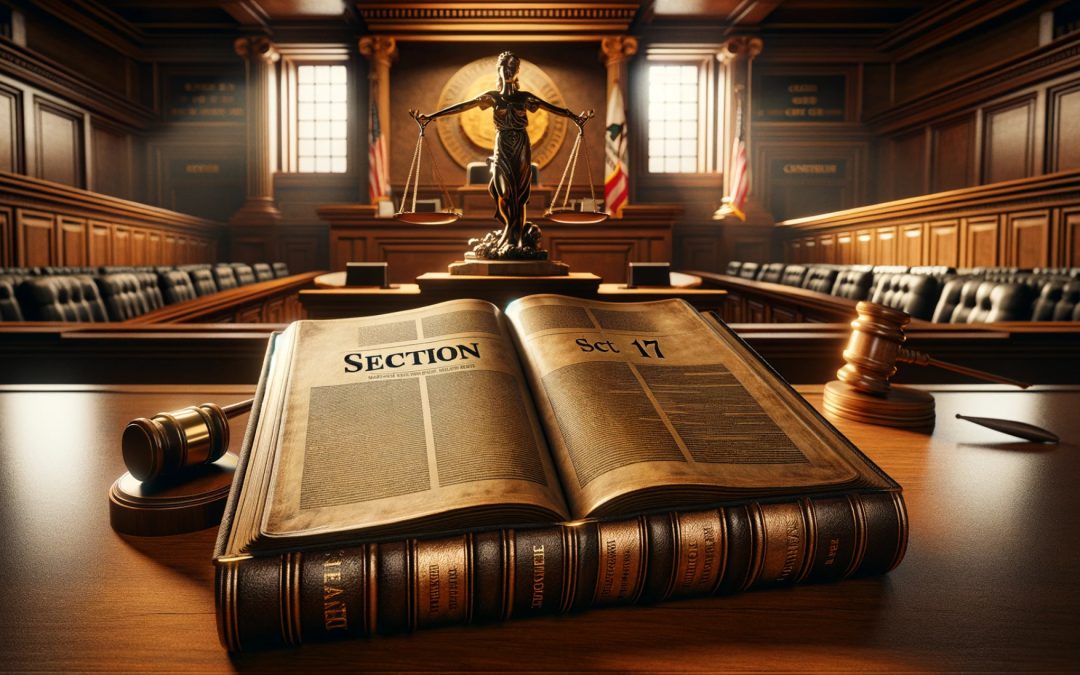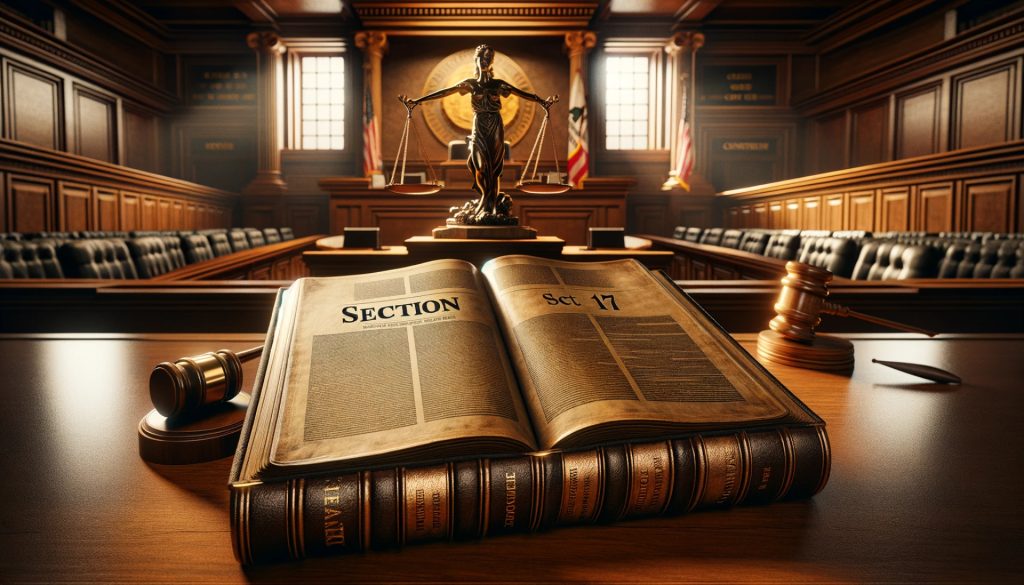In California, the Penal Code Section 17 is an essential statutory law that addresses how crimes are classified as misdemeanor or felony offenses, and the reduction of misdemeanors to infractions.
However, the subtleties of this code may be quite complicated, so understanding them is necessary not only for legal professionals but also for those facing criminal charges.
In this article, we will analyze the different sections of California Penal Code 17 to take a broad look at its provisions.
Introduction to Penal Code Section 17
California 17 Penal Code is the basis for criminal classification in the state. The distinctions between felonies and misdemeanors, as well as infractions, are outlined here, although there are no set rules for classification.
When it comes to criminal offenses, the California Penal Code Section 17 recognizes that not all crimes are born equal and admits the necessity to draw distinctions among different types of crimes. By doing so, it ensures that the punishment fits the crime and promotes a fair and just legal system.
One of the key aspects of Penal Code Section 17 is the gradation it makes among felonies, misdemeanors, and infractions. Felonies are extreme crimes, usually involving violence or a grave nature. These carry severe penalties and most of them lead to imprisonment within the state system.
In contrast, misdemeanors are less serious crimes and are punishable by imprisonment in the county jail or high fines. Finally, infractions are minor offenses normally punishable by fines rather than jail time.
However, it is important to note that not all crimes are black and white. Even though something might be considered a serious offense or a felony, there’s room for understanding and second chances. But we’ll discuss that later on, so keep reading!
Section 17(a): Classification of Crimes
Those who are classified in Penal Code Section 17 should gain better awareness about the potential level of criminal liability they may face. Let’s take a closer look:
Definition of a Felony
Now, let’s delve deeper into the world of felonies. A felony is a serious crime and the typical punishment for committing one is incarceration for over a year. Examples of felonies include violent crimes[1] such as murder, rape, or robbery.
In California, felonies are classified based on their severity, not categories like A to C or 1 to 4 like many other states. However, California uses a different system for classifying felonies, with three categories. Let’s take a closer look:
- Felony: This is the most serious category and carries the harshest penalties, including life imprisonment or even the death penalty[2] for certain offenses.
- Strike felony: This is a specific type of felony that carries enhanced penalties, even potentially a mandatory sentence of life in prison with the possibility of parole, depending on the number and type of prior strike convictions. Some important aspects to consider are:
- One prior strike conviction usually doubles the punishment for the current offense but does not automatically lead to life in prison.
- Three or more “violent strike” convictions typically trigger a mandatory sentence of 25 years to life in prison.
- Wobbler: This is a crime that can be charged as either a felony or a misdemeanor[3], depending on the specific circumstances of the case and the defendant’s criminal history.
Definition of a Misdemeanor
A misdemeanor is a less serious crime compared to a felony. They are usually crimes punishable by imprisonment for a shorter term, typically less than one year in length.
Examples of misdemeanors include petty theft, simple assault, or driving under the influence (DUI). They may not be so harsh as felony penalties, but sanctions for a misdemeanor offense can have substantial effects as well.
Definition of an Infraction
Infractions are the least serious offenses and are often referred to as “tickets” or minor violations. These crimes are usually punished with a fine, community service, or some other non-custodial sentence.
Such common infractions include traffic offenses, neglecting to keep up-to-date on occupational licensing requirements, or public nuisance charges[4]. Though generally thought harmless, piling up infractions in excess can bring about penalties and further legal consequences.
Section 17(b): Reclassification of Felonies to Misdemeanors
Under Section 17(b)[5] of the California Penal Code, some felonies may be reclassified as misdemeanors, potentially impacting the seriousness of the offense and reducing the associated penalties.
That’s where a special rule called “wobblers”[6] comes in. This basically means judges can sometimes downgrade a felony to a misdemeanor if they think it’s the right thing to do. They consider things like the person’s past, what happened exactly, and whether they seem like they can learn from their mistakes and become a better person.
Wobbler offense offers folks arrested for felonies a chance to resolve their matter less harshly and more importantly, receive treatment for their problems rather than enduring lengthy prison terms.
Authority for Reclassification
The authority for reclassification rests with the courts, which must consider many factors before deciding to reclassify from convicted of a felony to a misdemeanor. These factors include the nature of the offense[7], the defendant’s criminal history, and overall rehabilitation potential[8].
In making sentencing decisions, the court prioritizes both fairness and societal reintegration. By carefully considering a defendant’s individual circumstances, they strive to achieve a just outcome that promotes rehabilitation and fosters positive contributions to the community.
Specific Conditions for Reclassification of Felonies to Misdemeanors
Section 17(b) outlines specific conditions that must be met for a felony to be eligible for a reduction. It’s not always the same, but usually involves things like not hurting anyone, working with the police, or taking part in a special program the court orders.
By doing these things, someone basically shows they understand their mistakes and are actively trying to fix them. This can lead to a motion to reduce a sentence and a better chance of getting back on their feet.
Implications of Reclassification
To reduce a felony to a misdemeanor carries less penalties and hence offers a greater possibility of receiving a less severe punishment. For example, an offender who had been sentenced to many years in prison might be paroled on probation, face a shorter term of imprisonment, or even receive a punishment other than imprisonment. Reclassification allows individuals the opportunity to change, to put themselves on the road to social recovery.
Section 17(c): Misdemeanor for All Purposes
In California, Section 17(c) establishes that any offense classified as a misdemeanor carries equal weight across all legal contexts. This means that whether it’s within the realm of criminal law, civil matters, or any other relevant area, the consequences and severity of a misdemeanor charge remain consistent.
Section 17(c) ensures uniformity in how misdemeanors are perceived and addressed within the California 17 legal system, emphasizing their significance regardless of the specific circumstances or legal domain involved.
Section 17(d): Reducing Misdemeanors to Infractions
If you’re facing certain misdemeanor charges, there’s a law called Section 17(d) that might help. This section lets the court downgrade your offense to an even less serious “infraction,” like a traffic ticket.
Infractions usually come with much lighter punishments, like smaller fines or community service. Basically, Section 17(d) allows judges to consider the specific details of your case and tailor the outcome to fit the situation better. This means fairer treatment and a chance to avoid the harsher consequences of a misdemeanor conviction.
Section 17(e): Amendments and Updates
California Section 17(e) outlines how they can update old laws or add new ones when needed. Whether it’s because of new technology, different social situations, or just making things clearer, Section 17(e) helps keep California 17 laws fair, effective, and relevant. It’s like a built-in update button for the legal system, ensuring it serves the best interests of everyone and upholds justice and fairness for all.
Contact us for Additional Help
If you find yourself in need of legal assistance or have questions regarding the California Penal Code 17, it is crucial to seek the guidance of a qualified Los Angeles criminal defense attorney, and Manshoory Law is here to help!
Whether you’re facing complex litigation, need guidance navigating intricate legal matters, or seek personalized counsel for your specific needs, our team is here to help. With a wealth of experience and a dedication to client satisfaction, we’re committed to providing you with the support and representation you deserve.
Contact us today for additional help and take the first step towards achieving peace of mind and favorable outcomes!
Conclusion
In California, the criminal law system pc 17 forms the basis for determining which crimes are classified and reclassified.
People can make better decisions about how to handle legal charges they might face if they know what felonies, misdemeanors, and infractions mean. Also, the provisions in Section pc 17 provide chances for people to undergo rehabilitation and reenter society on the right foot.
As our legal system develops, Section 17 ensures that justice is served in California’s criminal justice system equally, and that’s when professional help comes in handy. Don’t hesitate to contact Manshoory Law today and start your journey to a successful legal outcome!
Reference
- https://manshoorylaw.com/blog/violent-crimes-in-california/
- https://www.justice.gov/usao/justice-101/sentencing#:~:text=The%20death%20penalty%20can%20only,to%20impose%20the%20death%20penalty
- https://manshoorylaw.com/misdemeanor-and-felony-consequences/
- https://manshoorylaw.com/blog/what-does-public-nuisance-mean/
- https://manshoorylaw.com/california-penal-code/penal-code-17b/
- https://manshoorylaw.com/blog/misdemeanor-felony-and-wobbler-offenses-in-california/
- https://www.justice.gov/archives/jm/criminal-resource-manual-133-second-factor-nature-alleged-offense
- https://www.ncbi.nlm.nih.gov/pmc/articles/PMC9034978/


